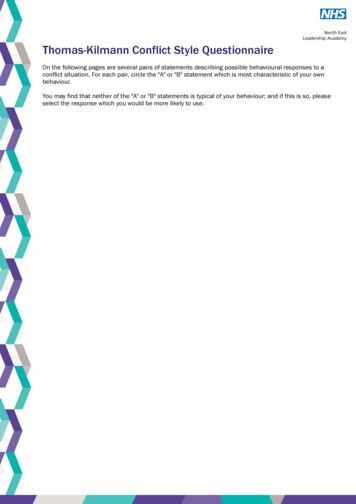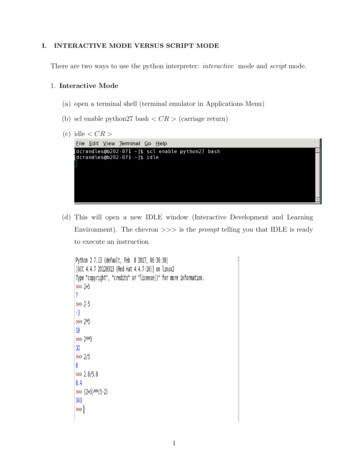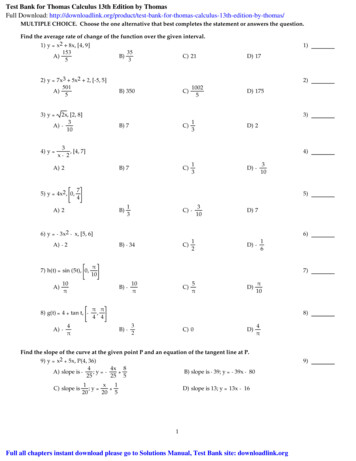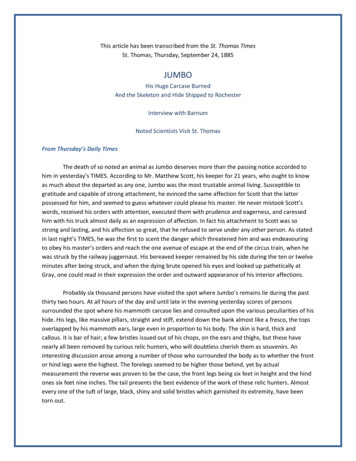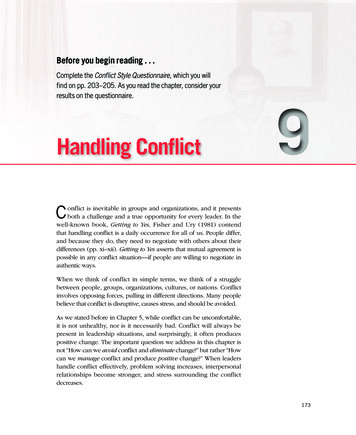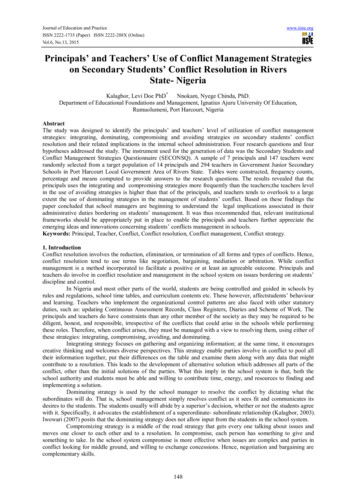
Transcription
THOMAS-KILMANN CONFLICT MODE QUESTIONNAIREConsider situations in which you find your wishes differing from those of another person. Howdo you usually respond to such situations?On the following pages are several pairs of statements describing possible behavioral responses.For each pair, please circle the "A" or "B" statement which is most characteristic of your ownbehavior. In many cases, neither the "A" nor the "B" statement may be very typical of yourbehavior, but please select the response which you would be more likely to use.When done answering, transfer your answers to the scoring sheet on the last page, and sumeach of the columns.1. A. There are times when I let others take responsibility for solving the problem.B. Rather than negotiate the things on which we disagree, I try to stress those thingsupon which we both agree.2. A. I try to find a compromise solution.B. I attempt to deal with all of another's and my concerns.3. A. I am usually firm in pursuing my goals.B. I might try to soothe the other's feelings and preserve our relationship.4. A. I try to find a compromise solution.B. I sometimes sacrifice my own wishes for the wishes of the other person.5. A. I consistently seek the other's help in working out a solution.B. I try to do what is necessary to avoid useless tensions.6. A. I try to avoid creating unpleasantness for myself.B. I try to win my position.
7. A. I try to postpone the issue until I have had some time to think about it.B. I give up some points in exchange for others.8. A. I am usually firm in pursuing my goals.B. I attempt to get all concerns and issues immediately out in the open.9. A. I feel that differences are not always worrying about.B. I make some effort to get my way.10. A. I am firm in pursuing my goals.B. I try to find a compromise solution.11. A. I attempt to get all concerns and issues immediately out in the open.B. I might try to soothe the other's feelings and preserve our relationship.12. A. I sometimes avoid taking positions which would create controversy.B. I will let another have some of their positions if they lets me have some of mine.13. A. I propose middle ground.B. I press to get my points made.14. A. I tell another my ideas and ask them for theirs.B. I try to show him the logic and benefits of my position.
15. A. I might try to soothe the other's feelings and preserve our relationship.B. I try to do what is necessary to avoid tension.16. A. I try not to hurt the other's feelings.B. I try to convince the other person of the merits of my position.17. A. I am usually firm in pursuing my goals.B. I try to do what is necessary to avoid useless tensions.18. A. If it makes the other person happy, I might let them maintain their views.B. I will let the other person have some of their positions if they let me have some of mine.19. A. I try to get all concerns and issues immediately out in the open.B. I try to postpone the issue until I have had some time to think it over.20. A. I attempt to immediately work through our differences.B. I try to find a fair combination of gains and losses for both of us.21. A. In approaching negotiations, I try to be considerate of the other person's feelings.B. I always lean toward a direct discussion of the problem.22. A. I try to find a position that is intermediate between mine and another person's.B. I assert my wishes.
23. A. I am often concerned with satisfying all my wishes.B. There are times when I let others take responsibility for solving problems.24. A. If the other's position seems important to them, I would try to meet their wishes.B. I try to get the other person to settle for a compromise.25. A. I try to show the other person the logic and benefits of my position.B. In approaching negotiations, I try to be considerate of the other person's wishes.26. A. I propose a middle ground.B. I am nearly always concerned with satisfying all my wishes.27. A. I sometimes avoid taking positions that would create controversy.B. If it makes the other person happy, I might let them maintain their views.28. A. I am usually firm in pursuing my goals.B. I feel that differences are not always worth worrying about.29. A. I propose middle ground.B. I feel that differences are not always worth worrying about.30. A. I try not to hurt the other person's feelings.B. I always share the problem with the other person so that we can work it out.
SCORING THE THOMAS-KILMANN CONFLICT MODE QUESTIONNAIRECompeting ABABBBABBABBTotal the number of letters circled in each haring)(Withdrawal)Solving)AWithdrawing(Smoothing)
THOMAS-KILMANN CONFLICT MODES: Interpreting Your ScoresYour profile of scores indicates the repertoire of conflict handling skills that you possess and use in conflict situations. One of the most often asked questions is"What are the right answers?" In this type of test, there are no "right" answers. All five modes of handling conflict are useful in various situations, and eachrepresents a set of useful social skills. The effectiveness of any handling of conflict depends on the requirements of the conflict and the skill that is employed.Each of us is capable of using all five conflict modes, and none of us can be characterized as having a single rigid style of dealing with conflict. However, becauseof personality traits or by habit, individuals tend to use one or two modes at a greater frequency than the others.DescriptionCompetitive“The Shark”Sharks force others toaccept their way,oblivious to needs orfeelings of others.Sharks believe conflictsare settled by oneperson winning and oneperson losing. Sharkswant to win and willfight at any cost to doso."Might makes right."Collaborative“The Owl”Owls confront openlyand fairly. Optimisticabout conflict, Owls arecommitted to theirpersonal goals and toothers goals. Owlsbegin discussion byidentifying openly thewishes of both, and arenever satisfied until asolution is found thatsatisfies both. “"Two heads are betterthan one."Compromising“The Fox”Foxes compromise. Afox will give up somegoals if you’ll give upsome of yours. The Foxis similar to the Owl,but less optimisticabout conflict bringingan improvedrelationship."Split the difference."Avoiding“The Turtle”Turtles believe it’shopeless to try toresolve conflict andavoid people and issuesthat may cause conflict.The turtle feels helplessin reaching personalgoals and refuses tocooperate with othersin reaching theirs."Leave well enoughalone."MottoConflict with this typemight feel like . . .Accommodating“The Teddy Bear”The Teddy Bearsoothes. More thananything else, TeddyBears want others tolike and accept them.Teddy Bears are quickto accommodate toothers and to ignoretheir own needsbecause they believeasking others to meetpersonal needs willharm the relationship."Kill your enemies withkindness."While you’re talking,Sharks are thinking ofthe next argument todefeat you.When Owls talk, theymay come on strong,but when you talk, theyare listening carefullyand sympathetically.When Foxes are talking,they’re diplomatic butpersuasive. When youtalk, the Fox is tryinghard to figure out somecompromise.Turtles neither talk norlisten. You seldom willget a chance to discussthe issues.When Teddy Bears talk,everything sounds justfine. When you talk,they’re listening andagreeing witheverything you say.
Conflict StyleCompeting “Shark”Collaborative “Owl”Compromising“Fox”Avoiding “Turtle”Accommodating“Teddy Bear”Situations where appropriate1. Issue is trivial2. Speed by decision is needed3. Unpopular course of action is implemented4. Necessary to overcome assertivesubordinates5. Unfavorable decision by the other partymay be costly to you6. Others lack expertise to make technicaldecision7. Issue is important to youSituations where inappropriate1. Issue is complex2. Issue is not important to you3. Both parties are equally powerful4. Decision does not have to be madequickly5. Subordinates possess high degreeof competence1. Issues are complex2. Synthesis of ideas is needed to come upwith better solutions3. Commitment is needed from other partiesfor successful implementation4. Time is available for problem solving5. One party alone cannot solve the problem6. Resources possessed by different partiesare needed to solve their commonproblems1. Task or problem is simple2. Immediate decision is required3. Other parties are unconcernedabout outcome4. Other parties do not have problemsolving skills1.2.3.4.Goals of parties are mutually exclusiveParties are equally powerfulConsensus cannot be reachedIntegrating or dominating style is notsuccessful5. Temporary solution to a complex problemis needed1. One party is more powerful2. Problem is complex enough toneed problem-solving approach1. Issue is trivial2. Potential dysfunctional effect ofconfronting the other part outweighsbenefits of resolution3. Cooling off period is needed1. Issue is important to you2. It is your responsibility to makedecisions3. Parties are unwilling to defer, issuemust be resolved4. Prompt attention is needed1. You believe that you may be wrong2. Issue is more important to the other party3. You are willing to give up something inexchange for something from the otherparty in the future4. You are in a position of weakness5. Preserving relationship is important1. Issue is important to you2. You believe that you are right3. The other party is wrong orunethical
THOMAS-KILMANN CONFLICT MODES: Interpreting Your Scores Your profile of scores indicates the repertoire of conflict handling skills that you possess and use in conflict situations. One of the most often asked questions is "What are the right answers?" In this type of test, there are no "right" answers. All five modes of handling conflict are useful in various situations, and each
